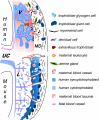Tolerance of the fetus by the maternal immune system: role of inflammatory mediators at the feto-maternal interface
- PMID: 14651750
- PMCID: PMC305337
- DOI: 10.1186/1477-7827-1-121
Tolerance of the fetus by the maternal immune system: role of inflammatory mediators at the feto-maternal interface
Abstract
The adaptive immune system of placental mammals has evolved to tolerate the fetus. Rejection of the fetus by adaptive immune responses is therefore a rare event, with abortion being caused more frequently by inflammation in the placenta. This review will cover recent aspects of immune privilege and the innate immune system at the feto-maternal interface, citing examples of the role played by microbial infections in fetal demise.
Figures




References
-
- Vacchio MS, Jiang SP. The fetus and the maternal immune system: pregnancy as a model to study peripheral T-cell tolerance. Crit Rev Immunol. 1999;19:461–480. - PubMed
Publication types
MeSH terms
Substances
Grants and funding
LinkOut - more resources
Full Text Sources
Medical

